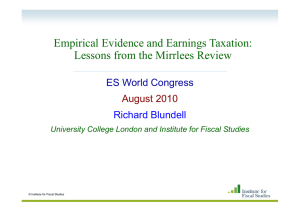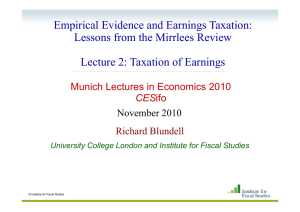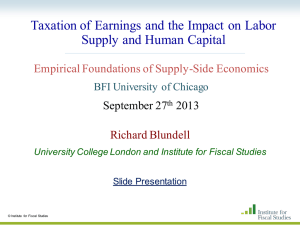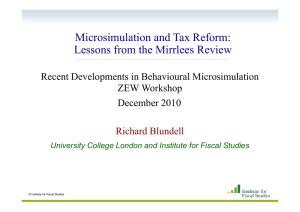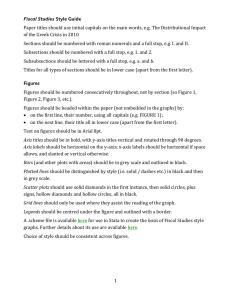Empirical Evidence and Earnings Taxation: Lessons from the Mirrlees Review
advertisement
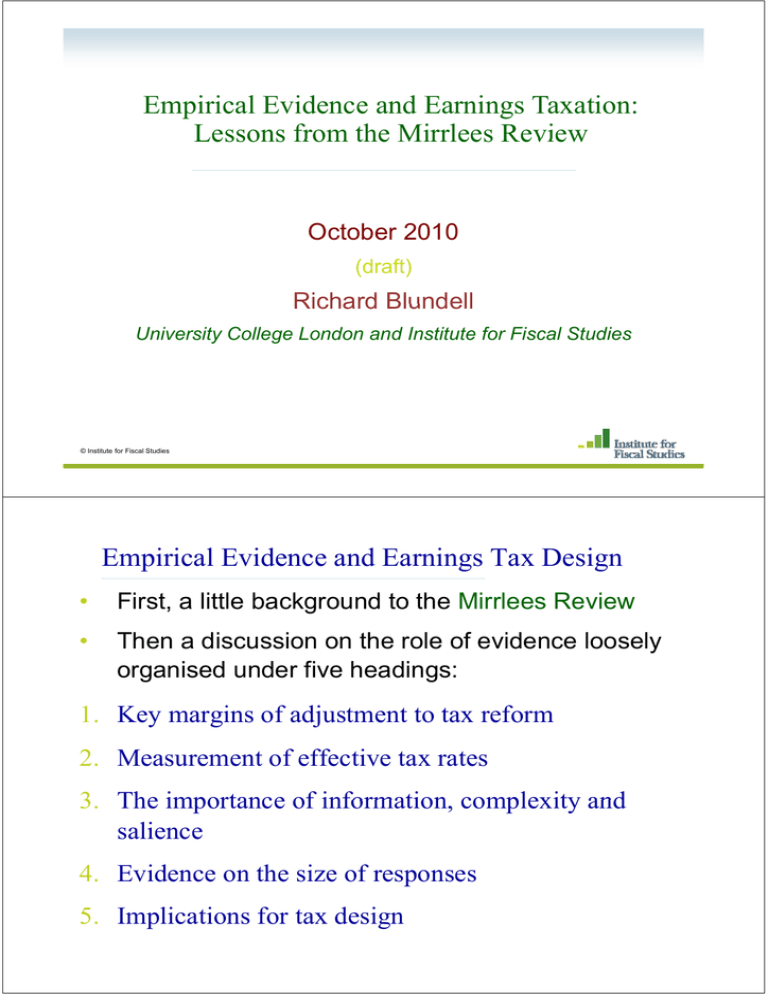
Empirical Evidence and Earnings Taxation:
Lessons from the Mirrlees Review
October 2010
(draft)
Richard Blundell
University College London and Institute for Fiscal Studies
© Institute for Fiscal Studies
Empirical Evidence and Earnings Tax Design
•
First, a little background to the Mirrlees Review
•
Then a discussion
Th
di
i on th
the role
l off evidence
id
lloosely
l
organised under five headings:
1. Key margins of adjustment to tax reform
2. Measurement of effective tax rates
3 The importance of information,
3.
information complexity and
salience
4. Evidence on the size of responses
5 Implications
5.
I li ti
for
f tax
t design
d i
Empirical Evidence and Earnings Tax Design
•
S b h di ((and
Sub-heading
d subtext)
bt t) ffor th
the ttalk:
lk
pp y Responses
p
at the Extensive Margin:
g
Labor Supply
What Do We Know and Why Does It Matter?
The extensive – intensive distinction is important
for a number
n mber of reasons:
•
Understanding responses to tax and welfare reform
– Heckman, Wise, Prescott, Rogerson, .. all highlight the
importance of extensive labour supply margin,
– perhaps too much….
•
The size of extensive and intensive responses are also key
parameters in the recent literature on earnings tax design
–
•
used heavily in the Mirrlees Review.
But the relative importance of the extensive margin is
specific to particular groups
–
I’ll examine a specific example of low earning families in
more detail in what follows
What is the Mirrlees Review?
• Review of tax design from first principles
– For modern open economies in general and UK in particular
– Reflect changes in the world, changes in our understanding and
increased empirical knowledge
• Two volumes:
- ‘Dimensions
Dimensions of Tax Design
Design’:: 13 chapters on specific areas coco
authored by international experts and IFS researchers, along
p commentaries – free on the web and at OUP
with 30 expert
- I will draw on contributions by Adam and Browne, Banks and
y , Laroque,
q , Moffitt,, Brewer,, Saez and
Diamond,, Hoynes,
Shephard.
- ‘Tax by
y Design’:
g 20 chapters
p
pprovidingg an integrated
g
picture
p
of
tax design and reform, written by the editors
The Mirrlees Review
Reforming the Tax System for the 21st Century
Editorial Team
Chairman: Sir James Mirrlees
Tim Besleyy ((LSE & IFS))
Richard Blundell (UCL & IFS)
Malcolm Gammie QC (One Essex Court & IFS)
James Poterba (MIT & NBER)
Stuart Adam (IFS)
Steve Bond (Oxford & IFS)
Robert Chote (IFS)
Paul Johnson (IFS & Frontier)
Gareth Myles (Exeter & IFS)
http://www.ifs.org.uk/mirrleesReview
Increased empirical knowledge: – some examples
•
labour supply responses for individuals and families
– at the intensive and extensive margins
– by age and demographic structure
•
taxable income elasticities
– top of the income distribution using tax return
information
•
income uncertainty
– persistence and magnitude of earnings shocks over
the life-cycle
•
ability to (micro-)simulate marginal and average rates
– simulate reforms
The focus here is on earnings taxation
• Leading example of the mix of theory and evidence
• Key implications for tax design
• Earnings taxation, in particular, takes most of the
strain in distributional adjustments of other parts of
the reform package (VAT base broadening, for
example).
example)
Thinking about Responses at the Intensive and
E t i Margin
Extensive
M i
•
•
⎧
h1+1/α
− β if h > 0
⎪c −
U = ⎨ 1 + 1/ α
⎪c
if h = 0
⎩
α is the intensive labour supply elasticity and she works when
the value of working at wage w exceeds the fixed cost β.
Write within period utility as
•
Convenient to describe the distribution of heterogeneity
g the conditional distribution of β g
given α,, F(β|
(β| α)) and
through
the marginal distribution of α.
•
The labour supply and employment rate for individuals of type
α, is
1+α
h( w, α ) = w
α
⎛w ⎞
and
d p ( w, α ) = F ⎜
⎟
1
+
α
⎝
⎠
Thinking about Responses at the Intensive and
E t i Margin
Extensive
M i
•
•
The intensive and the employment rate elasticity are
(1+α )
⎞
⎛ w(1+α ) ⎞
(1+α ) ⎛ w
f⎜
ε I (α ) = α and ε E (α ) = w
⎟/F⎜
⎟
1
+
α
⎝
⎠
⎝ 1+ α ⎠
The aggregate hours elasticity is a weighted sum across the
intensive and extensive margins
⎛ w1+α
⎞
d ln H 1
α
| α ⎟ + wα w1+α
= ∫ [α w F ⎜
d ln w H α
⎝ 1+ α
⎠
1
p( w, α )h( w, α )[ε I (α ) + ε E (α )]dG (α )
∫
Hα
Of course, quasi-linear utility is highly restrictive and we
expect income effects to matter
matter, at least for some types of
households – we use more general models with fixed costs
=
•
⎛ w1+α
⎞
f⎜
| α ⎟]dG (α )
⎝ 1+ α
⎠
•
So where are the key margins of response?
•
Evidence suggests they are not all the extensive
margin..
– Intensive
I t i andd extensive
t i margins
i both
b th matter
tt
– They matter for tax policy evaluation and earnings tax
design
– And they matter in different ways by age and
demographic groups
•
Getting it right for men
Employment for men by age – FR, UK and US 2007
100%
90%
FR
UK
US
80%
70%
60%
50%
40%
30%
20%
10%
0%
16 18 20 22 24 26 28 30 32 34 36 38 40 42 44 46 48 50 52 54 56 58 60 62 64 66 68 70 72 74
Blundell, Bozio and Laroque (2010)
Total Hours for men by age – FR, UK and US 2007
2000
FR
UK
1750
US
1500
1250
1000
750
500
250
0
16 18 20 22 24 26 28 30 32 34 36 38 40 42 44 46 48 50 52 54 56 58 60 62 64 66 68 70 72 74
Blundell, Bozio and Laroque (2010)
Total Hours for men by age in the UK: 1977 - 2007
2250
2000
2007
1977
1750
1987
1997
1500
1250
1000
750
500
250
0
Blundell, Bozio and Laroque (2010)
Key Margins of Adjustment
•
and for for women …..
Female Employment by age – US, FR and UK 1977
0.90
0.80
FR
UK
0.70
US
0.60
0.50
0.40
0 30
0.30
0.20
0.10
0.00
16 18 20 22 24 26 28 30 32 34 36 38 40 42 44 46 48 50 52 54 56 58 60 62 64 66 68 70 72 74
Blundell, Bozio and Laroque (2010)
Female Employment by age – US, FR and UK 2007
0.90
0.80
FR
UK
US
0.70
0 60
0.60
0.50
0.40
0 30
0.30
0.20
0.10
0 00
0.00
16
18 20 22 24
26 28 30 32
34 36 38 40
42 44 46 48
50 52 54 56
58 60 62 64
66 68 70 72
Blundell, Bozio and Laroque (2010)
Female Total Hours by age – US, FR and UK 2007
1600
FR
1400
UK
US
1200
1000
800
600
400
200
0
16
18
20
22
24
26
28
30
32
34
36
38
40
42
44
46
48
50
52
54
56
58
60
Blundell, Bozio and Laroque (2010)
62
64
66
68
70
72
74
74
Measuring Responses at the Intensive and Extensive Margin
•
Suppose the population share at time t of type j is qjt, then
total hours
J
H t = ∑ q jt H jt and
d H jt = p jt h jt
j =1
•
Changes in total hours per person written as the sum of
changes across all types of workers and the change in
structure of the population
H t − H t −1 = Δ t + St
where Δ t = ∑ j =1 Δ jt with Δ jt = q jt −1[ H jt − H jt −1 ]
J
•
We can also mirror the weighted elasticity decomposition
⎡
Δh j
Δp j ⎤
ΔH 1 J
∑ q j ⎢ p j hj
+ p j hj
⎥
H
H j =1 ⎢⎣
hj
p j ⎦⎥
And derive bounds on extensive and intensive responses for
finite changes
•
Decomposition of change in annual hours worked (1977-2007)
1400
United-States
2007 1308 h
2007: 1308 hours
1300
1977: 1212 hours
1200
1977: 1148 h
hours
1977: 1124 hours
1100
2007: 1094 hours 1000
2007: 953 hours 900
France
800
© Institute for Fiscal Studies United-Kingdom
Change in structure
Women 55-74
Men 55-74
Women 30-54
M 30-54
Men
30 54
W
Women
16-29
16 29
Men 16-29
Blundell, Bozio and Laroque (2010)
Bounds on Intensive and Extensive Responses (1977-2007)
FR
Year
Men
16-29
Women
16-29
Men
30-54
Women
30-54
Men
55-74
Women
55-74
I-P, I-L
[-37,-28]
[-23, -19]
[-59, -56]
[-49, -35]
[-11, -8]
[-10, -9]
E-L,, E-P
[[-54,, -45]]
[[-19,, -16]]
[[-27,, -23]]
[[71,, 85]]
[[-28,, -25]]
[[6,, 7]]
Δ
-82
-38
-82
36
-36
-3
[-42, -36]
[-26, -23]
[-48, -45]
[-3, -2]
[-22, -19]
[-8, -6]
E-L, E-P
[-35, -29]
[14, 17]
[-25, -22]
[41, 41]
[-23, -20]
[15, 17]
Δ
-71
-9
-70
39
-42
10
[-6, -6]
[1, 1]
[-5, -5]
[14, 19]
[3, 3]
[3, 5]
E-L, E-P
[-13, -13]
[21, 21]
[-14, -14]
[72, 77]
[3, 3]
[33, 35]
Δ
-19
22
-19
90
6
38
UK I-P, I-L
US I-P, I-L
© Institute for Fiscal Studies Blundell, Bozio and Laroque (2010)
Why is this distinction important for tax design?
•
Some key lessons from recent tax design theory (Saez
(2002, Laroque (2005), ..)
large extensive elasticity at low earnings can ‘turn
turn
• A ‘large’
around’ the impact of declining social weights
– implying a higher optimal transfer to low earning workers
than to those out of work
– a role for earned income tax credits
• But how do individuals perceive the tax rates on earnings
implicit in the tax credit and benefit system - salience?
– are individuals more likely to ‘take-up’ if generosity
increases? – marginal rates become endogenous…
• Importance of margins other than labo
labourr ssupply/hours
ppl /ho rs
– use of taxable income elasticities to guide choice of top tax
rates
•
Importance of dynamics and frictions
An Analysis in Two Steps
• The first step (impact) is a positive analysis of household
decisions. There are two dominant empirical approaches
to the measurement of the impact of tax reform…
reform
– both prove useful:
•
1. A ‘quasi-experimental’ evaluation of the impact of
historic reforms /and randomised experiments
•
2. A ‘structural’ estimation based on a general discrete
choice model with (unobserved) heterogeneity
• The second step (optimality) is the normative analysis or
p
p
policy
y analysis
y
optimal
– Examines how to best design benefits, in-work tax
credits and earnings tax rates with (un)observed
heterogeneity and unobserved earnings ‘capacity’
Alternative approaches to measuring the impact:
• Structural model
– Simulate effect of actual or hypothetical reforms
– Useful for optimal design too, but, robust?
• Quasi-experiment/Difference-in-differences
– Compares
p
outcomes of eligibles
g
and non-eligibles
g
and
estimates ‘average’ impact of past reform
– Only indirectly related to what is needed for optimal
design
– At best
best, partially identify parameters of interest
• Randomised experiment? SSP?
Focus here on tax rates on lower incomes
Main defects in current welfare/benefit systems
• Participation tax rates at the bottom remain very high in
UK and elsewhere
• Marginal tax rates are well over 80% for some low
income working families because of phasing-out
phasing out of
means-tested benefits and tax credits
– Working Families Tax Credit + Housing Benefit in UK
– and interactions with the income tax system
– for example, we can examine a typical budget
constraint for a single mother in the UK…
The interaction of WFTC with other benefits in the UK
Low wage
lone parent
£300
£250
Local tax rebate
Rent rebate
WFTC
Income Support
Net earnings
Other income
£200
£150
£100
£50
hours of work
48
44
40
36
32
28
24
20
16
8
12
4
0
£0
Strong
g
implications
for EMTRs,
PTRs and
labour supply
40%
4
50%
%
60%
70%
80
0%
Average EMTRs across the earnings distribution for different
family types
0
100
200
300
400
500
600
700
800
900
1000 1100 1200
Employer cost (£/week)
Single, no children
P
Partner
not working,
ki
no children
hild
Partner working, no children
Lone parent
P
Partner
not working,
ki
children
hild
Partner working, children
Source:
Tax by Design,
Mirrlees
Review
Mirrlees
Review
(2010)
Can the reforms explain weekly hours worked?
Single Women (aged 18-45) - 2002
Blundell and Shephard (2009)
Hours’ distribution for lone parents, before WFTC
Blundell and Shephard (2009)
Hours’ distribution for lone parents, after WFTC
Blundell and Shephard (2009)
Hours trend for low ed lone parents in UK
1600
1550
1500
1450
1400
1350
1300
1250
1200
1985 1986 1987 1988 1989 1990 1991 1992 1993 1994 1995 1996 1997 1998 1999 2000 2001 2002 2003 2004 2005 2006 2007 2008
Employment trends for lone parents in UK
WFTC
0.8
0.75
0.7
0.65
0.6
College
0.55
No College
No College
0.5
0.45
0.4
0.35
0.3
1985 1986 1987 1988 1989 1990 1991 1992 1993 1994 1995 1996 1997 1998 1999 2000 2001 2002 2003 2004 2005 2006 2007 2008
Matching and anticipation
WFTC Reform: Quasi-experimental Evaluation
Matched Difference-in-Differences
Average Impact on % Employment Rate of Single Mothers
Single Mothers Marginal
Effect
F il
Family
45
4.5
Resources
Survey
Labour Force
4.7
Survey
Standard
Error
1 55
1.55
Sample Size
0.55
233,208
25 163
25,163
Data: FRS, 45,000 adults per year, Spring 1996 – Spring 2002.
B
Base
employment
l
t level:
l
l 45% iin S
Spring
i 1998.
1998
Matching Covariates: age, education, region, ethnicity,..
Can use thi
C
this quasi-experimental
i
i
t l evidence
id
to
t (partially)
( ti ll )
validate the structural model
Keyy features of the structural model
U (ch , h, P; X , ε )
yp
y approximated
pp
byy shape
p constrained sieves
typically
Preferences
• Structural model allows for
- unobserved work-related fixed costs
- childcare costs
- observed and unobserved heterogeneity
- pprogramme
g
participation
p
p
‘take-up’
p costs
• See Blundell and Shephard (2009)
Importance of take-up and information/hassle costs
0
Pro
obability of take-up
.2
.4
.6
..8
1
Variation in take-up
pp
probability
y with entitlement to FC/WFTC
0
50
100
150
FC/WFTC entitlement (£/week, 2002 prices)
Lone parents
Couples
© Institute for Fiscal Studies
Structural Model Elasticities – low education lone parents
(a) Youngest Child Aged 5-10
Weekly
Earnings
0
Density
Extensive
Intensive
0.280 (.020)
0.321 (.009)
0.152 (.005)
0.058 (.003)
0.820 (.042)
0.085 (.009)
0.219 (.025)
0.194 (.020)
0.132 (.010)
0 4327
0.4327
50
0.1575
150
0.1655
250
0.1298
350
0.028
Employment elasticity
Blundell and Shephard (2009)
200
Structural Model Elasticities – low education lone parents
(b) Youngest Child Aged 11-18
Weekly
Earnings
0
Density
Extensive
Intensive
0.164 ((.018))
0.193 (.008)
0.107 ((.004))
0.045 (.002)
0.720 (.036)
0.130 ((.016))
0.387 (.042)
0.340 ((.035))
0.170 (.015)
0.3966
50
0.1240
150
0.1453
250
0.1723
350
0.1618
Employment elasticity
Blundell and Shephard (2009)
Structural Model Elasticities – low education lone parents
(c) Youngest Child Aged 0-4
Weeklyy
Earnings
Densityy
Extensive
Intensive
0
0.5942
50
0.1694
0.168 (.017)
0.025 (.003)
150
0 0984
0.0984
0 128 ((.012)
0.128
012)
0 077 ((.012)
0.077
012)
250
0.0767
0.043 (.004)
0.066 (.010)
350
0 0613
0.0613
0 016 ((.002)
0.016
002)
0 035 ((.005)
0.035
005)
Participation elasticity
0.536 (.047)
• Differences in intensive and extensive margins by age and
demographics have strong implications for the design of the tax
schedule...
h d l
N
Non-monotonic
t i in
i age off youngestt child
hild
But do we believe the structural model estimates?
Structural Simulation of the WFTC Reform:
WFTC Tax Credit Reform
All
Change in employment rate:
y-child
0 to 2
3.09
0 59
0.59
0.71
0 14
0.14
6.95
0 74
0.74
1.79
02
0.2
Average change in hours:
y-child
3 to 4
7.56
0 91
0.91
2.09
0 23
0.23
y-child
5 to 10
7.54
0 85
0.85
2.35
0 34
0.34
y-child
11 to 18
4.96
0 68
0.68
1.65
02
0.2
Notes: Simulated on FRS data; Standard errors in italics.
– relatively ‘large’ impact
Blundell and Shephard (2009)
Impact of WFTC and IS reforms on lone parent, 2 children
W
Weekly
net inco
ome
£300
1997
2002
8
16 20
£250
£200
£150
£100
0
4
12
24 28
32
36 40
44
Hours/week
•
Notes: Two children under 5. Assumes hourly wage of £4.10, no housing costs or council tax
liability and no childcare costs.
48
Structural Simulation of the WFTC Reform:
Impact of all Reforms
All
Change in employment rate:
Average change in hours:
4.89
0.84
1.02
0 23
0.23
y-child
0 to 2
0.65
0.6
0.01
0 21
0.21
y-child
3 to 4
5.53
0.99
1.15
0 28
0.28
y-child y-child
5 to 10 11 to 18
6.83
4.03
0.94
0.71
1.41
1.24
0 28
0.28
0 22
0.22
• shows the importance of getting the effective tax rates right
especially when comparing with quasi-experiments.
• Compare
p
with experiment
p
or q
quasi-experiment.
p
Evaluation of the ‘ex-ante’ structural model
• The diff-in-diff impact parameter can be identified from the
structural evaluation model
• Simulated diff-in-diff parameter
• The structural model then defines the average impact of the
policy on the treated as:
α SEM ( X ) = Pr[h > 0 | X , D = 1] − Pr[h > 0 X , D = 0]
• Compare
C
simulated
i l t d diff-in-diff
diff i diff momentt with
ith diff-in-diff
diff i diff
DD
αSEM
=∫
X
∫
X
T =1,t =1
f
(
X
,
ε
,
D
=
1)
)
dF
dFX −∫
ε
∫
ε
⎡
− ⎢∫ f ( X , ε , D = 0)dFεT =0,,t =1dFX − ∫
X
⎣ε
X
T =1,t =0
f
(
X
,
ε
,
D
=
0)
)
dF
dFX
ε
∫
ε
⎤
T =0,,t =0
f
(
X
,
ε
,
D
=
0)
dF
dF
ε
X⎥
∫ε
⎦
Evaluation of the ex-ante model
• The simulated diff-in-diff parameter from the structural
evaluation model is precise and does not differ
significantly from the diff-in-diff estimate
• Compare
C
simulated
i l t d diff-in-diff
diff i diff momentt with
ith diff-in-diff
diff i diff
– .21 (.73), chi-square p-value .57
• Consider additional moments
– education:
d ti
low
l education:
d ti
0.33
0 33 (.41)
( 41)
– youngest child interaction
• Youngest child aged < 5: .59 (. 51)
• Youngest
Y
t child
hild agedd 5-10:
5 10 .31
31 (.35)
( 35)
Structural Model Comparisons
© Institute for Fiscal Studies Blundell and Shephard (2009)
A optimal tax design framework
• Assume earnings (and certain characteristics) are all that is
observable to the tax authority
– relax below to allow for ‘partial’ observability of hours
Social welfare,
welfare for individuals of type X
W=
∫ ∫ε Γ(U (wh
− T (w, h ; X ), h ; X , ε ))dF (ε )dG(w; X )
w, X
The tax structure T(.) is chosen to maximise W, subject
to:
∫ ∫ε T ( wh , h ; X )dF (ε )dG ( w; X ) ≥ T (= − R )
w, X
for a given R.
R
Control preference for equality by transformation function:
Γ (U | θ ) =
(
(exp
U)
{
θ
1
θ
− 1}
when
h θ is
i negative,
ti the
th function
f ti favors
f
the
th equality
lit off
utilities. θ is the coefficient of absolute inequality aversion.
If θ < 0 then analytical solution to integral over (Type I
extreme-value) j state specific errors
1
⎡⎣ Γ (1 − θ ) ⋅ (exp u ( j ))θ − 1⎤⎦
θ
Want robust policies for fairly general social welfare
weiaghts
Implied Optimal Schedule, Youngest Child Aged 5-11
Blundell and Shephard (2009, Figure 3)
Weekly earnings
April 2002 prices
Implied Optimal Schedule, Youngest Child Aged 0-4
Part-time Optimal Hours rule
Blundell and Shephard (2009)
Weekly earnings
April 2002 prices
Implied Optimal Schedule, Youngest Child Aged 11-18
• Suggests ‘dynamic’ tax incentives according to age of (youngest) child
• Redistributing towards early years (see Table 10 in Blundell and Shephard)
Pareto Improving Reforms
• All these results so far derived under the assumption of a
specific class of social welfare function with varying degrees of
inequality aversion
aversion.
• Supposed we are concerned with the extent to which these
features are also implied solely by efficiency
efficiency.
• To that end, we wish to identify a set of reforms that result in
Pareto improvements.
improvements
• We take the actual 2002 tax/transfer systems T and calculate
the maximized value of utility for all X and all (ε) subject to the
individual incentive compatibility constraint and individual
budget constraint.
• With hours rules and integrating out over X and unobserved
productivity, the results point to a small increase in out-of-work
i
income,
ttogether
th with
ith a reduction
d ti iin th
the size
i off th
the partt time
ti
hours bonus and a large increase in the full-time hours bonus.
Implications for Tax Reform
• Change transfer/tax rate structure to match lessons from
‘new’ optimal tax analysis and empirical evidence
• Similar design framework for family labour supply and early
retirement
• Key role of labour supply responses at the extensive and
intensive margins
• Both matter but differ by gender, age, education and family
composition
– lone parents, married parents, pre-retirement low earners.
• Results for lone p
parents suggest
gg
lower marginal
g
rates at the
bottom
– means
means-testing
testing should be less aggressive
– at least for some key groups =>
Implications for Tax Reform
• Life-cycle
Lif
l view
i
off ttaxation
ti
– distinguish by age of (youngest) child for mothers/parents
– pre-retirement ages
– effectivelyy redistributing
g across the life-cycle
y
– a ‘life-cycle’ rearrangement of tax incentives and welfare
payments to match elasticities and early years investments
– results in Tax by Design show significant employment and
earnings increases
• Hours rules? – at full time for older kids,
– welfare gains depend on ability to monitor hours
• Dynamics and frictions?
– some time
ti
to
t adjust
dj t but
b t little
littl iin th
the way off experience
i
effects
ff t
for low skilled
Dynamic effects on wages for low income welfare
recipients?
6
Hourly rea
H
al wages
6.5
7
7.5
8
8.5
SSP: Hourly wages by months after RA
0
10
20
30
40
Months after random assignment
control
50
60
experimental
© Institute for Fiscal Studies
10
00
M
Monthly
earnings
e
200
300
400
SSP: Monthly earnings by months after RA
0
10
20
30
40
Months after random assignment
control
t l
© Institute for Fiscal Studies
experimental
i
t l
50
60
Evidence on experience effects among low skilled
•
In the SSP Earnings and employment line up with
control group after time limit is exhausted
–
Little evidence of employment enhancement or wage
progression
•
Other evidence, Taber etc, show some progression
but quite small
•
Remains a key area of research
–
ERA P
Policy
li iin UK
UK.
© Institute for Fiscal Studies
Some Additional References:
Besley, T.
Besley
T and S
S. Coate (1992)
(1992), “Workfare
Workfare versus Welfare: Incentive Arguments for Work
Requirement in Poverty Alleviation Programs”, American Economic Review, 82(1), 249261.
Blundell, R. A. Bozio and G. Laroque (2010), ‘Extensive and Intensive Margins of Labour
Supply: Working Hours in the US, UK and France’, mimeo IFS,
http://www.ucl.ac.uk/~uctp39a/BBL-16-10-10-rb.pdf
Blundell, R.W., Duncan, A. and Meghir, C. (1998), "Estimating Labour Supply
Responses using Tax Policy Reforms", Econometrica, 66, 827-861.
Blundell R
Blundell,
R, Duncan
Duncan, A
A, McCrae
McCrae, J and Meghir
Meghir, C
C. (2000)
(2000), "The
The Labour Market Impact of
the Working Families' Tax Credit", Fiscal Studies, 21(1).
Blundell, R. and Hoynes, H. (2004), "In-Work Benefit Reform and the Labour Market", in
Richard Blundell, David Card and Richard .B. Freeman (eds) Seeking a Premier League
Economy. Chicago: University of Chicago Press.
Blundell, R
Blundell
R. and MaCurdy (1999)
(1999), "Labour
Labour Supply: A Review of Alternative Approaches"
Approaches ,
in Ashenfelter and Card (eds), Handbook of Labour Economics, Elsevier North-Holland.
Blundell, R. and A. Shephard (2009), ‘Employment, Hours of Work and the Optimal
T
Taxation
ti off Low
L
Income
I
F ili ’ IFS Working
Families’,
W ki paper, updated
d t d version
i
http://www.ucl.ac.uk/~uctp39a/Optimal-17-10-10-figures-rb.pdf
Brewer M.
Brewer,
M A
A. Duncan
Duncan, A
A. Shephard
Shephard, M-J
M J Suárez,
Suárez (2006)
(2006), “Did
Did the Working Families Tax
Credit Work?”, Labour Economics, 13(6), 699-720.
Card, David and Philip K. Robins (1998), "Do Financial Incentives Encourage Welfare
R i i t T
Recipients
To W
Work?",
k?" Research
R
h iin L
Labor
b E
Economics,
i
17 pp 1
17,
1-56.
56
Chetty, R. (2008), ‘Sufficient statistics for welfare analysis: a bridge between structural
and reduced-form methods’, National Bureau of Economic Research ((NBER),
) Working
g
Paper 14399
Diamond, P. (1980): "Income Taxation with Fixed Hours of Work," Journal of Public
Economics 13,
Economics,
13 101-110
101-110.
Eissa, Nada and Jeffrey Liebman (1996), "Labor Supply Response to the Earned
Income Tax Credit", Quarterly Journal of Economics, CXI, 605-637.
Immervoll, H. Kleven, H. Kreiner, C, and Saez, E. (2005), `Welfare Reform in European
Countries: A Micro-Simulation Analysis’ Economic Journal.
Keane, M.P. and Moffitt, R. (1998), "A Structural Model of Multiple Welfare Program
Participation and Labor Supply", International Economic Review, 39(3), 553-589.
Laroque, G. (2005), “Income
Income Maintenance and Labour Force Participation”,
Participation ,
Econometrica, 73(2), 341-376.
Mirrlees, J.A. (1971), “The Theory of Optimal Income Taxation”, Review of Economic
Studies 38,
Studies,
38 175
175-208.
208
Moffitt, R. (1983), "An Economic Model of Welfare Stigma", American Economic Review,
73(5), 1023-1035.
Phelps, E.S. (1994), “Raising the Employment and Pay for the Working Poor”, American
Economic Review, 84 (2), 54-58.
Saez, E. (2002): "Optimal Income Transfer Programs: Intensive versus Extensive Labor
Supply Responses," Quarterly Journal of Economics, 117, 1039-1073.
